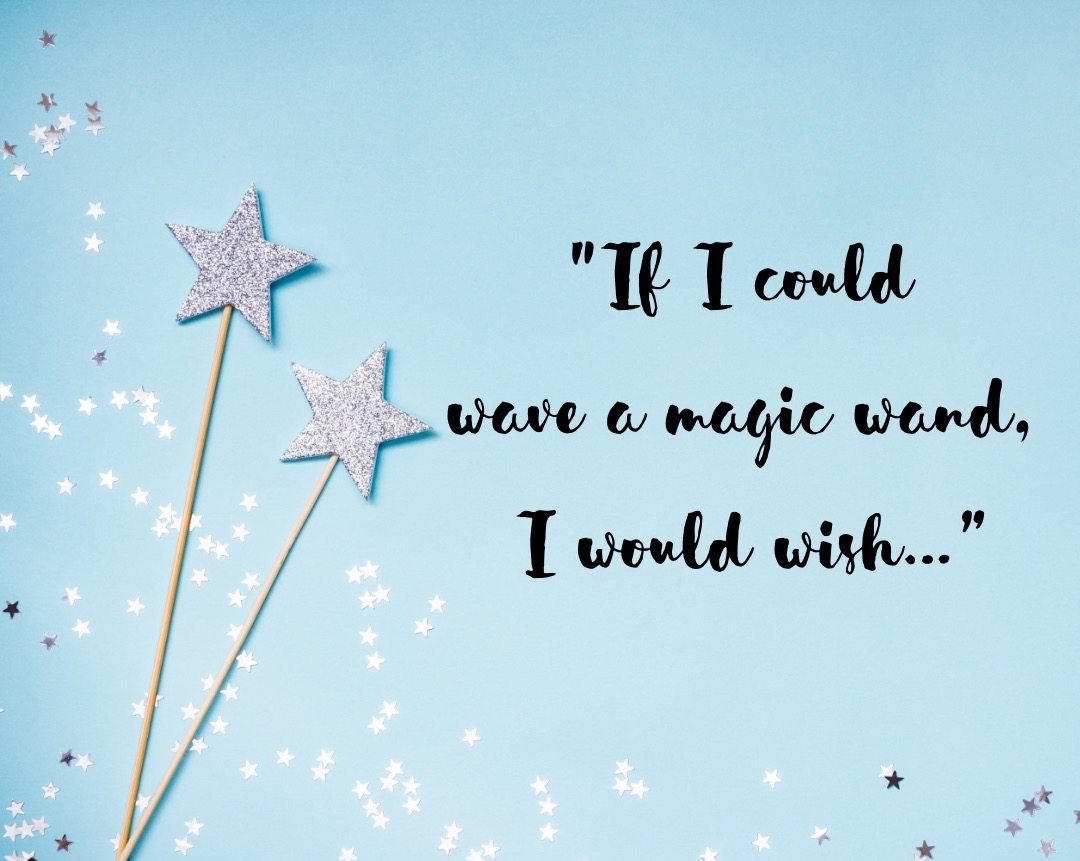
Jun 10, 2021 | Action, Authenticity, Courage, Intention, Leadership, Truth

…I would wish for organizations and leaders everywhere to seek to know their truth and be bold and courageous enough to live it.
I’ve witnessed the power of “knowing and living your truth” both in my own life experiences as well as with my clients in theirs. To me, it’s the difference between living an ordinary versus an extraordinary life. Between sleep walking through your life versus tapping into your most full, amazing self and unleashing your gifts in the world.
My “one wish” reflects the essence of how I most want to live my life and help others live theirs. I like the image of water and stepping stones to describe it.
Water represents two things as a constant…
Presence: You can’t seek to know and live your truth if you’re not paying attention. If you’re caught up in all the stuff of life and not noticing, you’re gonna miss it. And I get it, lives are full. Reeeally full. The aim is to “do” your rich, robust life while slowing the pace enough to “be” and focus your attention. It’s both challenging and possible, requiring some serious, conscious choice making, not to mention loads of courage.
Knowing and Loving Yourself: You’ve got to care…about you. YOU have to matter to you. Ground zero in knowing yourself and knowing your truth is first loving yourself (and for organizations, it’s about loving the “entity” as a living breathing organism…its people, mission, purpose, its reason for being).
Next, the stones represent…
a progression of steps I believe are present on the pathway to knowing and ultimately living your truth – what I call the “truth journey.”
- Presenting moment: First, there’s a trigger – an event or situation that swings a person’s or an organization’s pendulum to either dissonance (things like exhaustion, burn-out, hopelessness, crisis, failure, conflict) or resonance (imagine ease, energy, joy, excitement, thriving). You have this experience, and your emotions get stirred, often strongly. Accompanying this moment, is an internal sensation – I’ve experienced it as unsettledness, restlessness, a stirring, or insatiable yearning. And like a nagging 3-year-old, it just won’t go away until I address it head on.
- Stillness: Regardless of whether the experience is positive or negative, it’s important to stop and “sit with it.” If it’s particularly challenging, our tendency is to push it away, busy ourselves, or pretend altogether that it doesn’t exist. Resist the urge! It sounds counterintuitive to say “C’mon! Pull up a chair and sit with that misery for a while!” But it really is important to do just that – to stop, get quiet, be with what you’re sensing and thinking, and reflect, “What is this ‘thing’ trying to communicate to me? What knowledge and information can I get from it?”
- Clarity: In this pause and inquiry of the stillness, the answers could come quickly, almost instantly, or it could take days, weeks, months, even. I promise, there’ll come a time of greater clarity when the knowing appears – it might arrive with gusto like an ah-ha or break through, or it can come almost unnoticed as the slightest movement like a cloud floating by. You’ll know it when you sense a shift inside you – the dots connect, suddenly things make sense, or you might feel an ease, a lightness, or a rise in your energy.
- Choice: Next comes the most pivotal point in the process – you arrive at a choice point. Let’s say you’ve been frustrated in your job for a while. You haven’t been happy for a long time, maybe never. You’re burned out, exhausted, and feeling empty. Then comes the “event” that causes you to burst, “I’ve had it! I’m done!” And here you are…hello choice. You start contemplating your situation and exploring options. Often what happens here is we do what’s easy and take the path of least resistance: we stay, we tolerate, we settle, we endure. It’s here that I stand the firmest (and most compassionate) with my clients, because I can see what they can’t – their gifts, potential, resources, and courage (even if only a glimmer). I help them consider choices that empower, harness their strengths, and connect them to their passion.
- Action: In my opinion, the most important consideration here is that your actions align with your values and what most fulfills you. One of the perils that gets in the way of action is living in the place of “should.” With the job example above…“I should stay. After all, people are counting on me, proving my loyalty is important, it might get better…” If you’re an organization considering these steps, it might sound like “We should continue this program. We’ve been delivering it for 20 years, and a lot of people count on us. The program may be making little revenue and have ‘run its course,’ but there would be a public outcry if we stopped.” To take action, first tune into your “why,” your purpose, to what calls to you and lights you up. From there, make your plan and work your plan.
- Live: Once in action, live fully into the choice you’ve made and the path forward…no second guessing, no wondering if you did the right thing. Bravely, boldly go! As an individual, of course there’ll be personal check-ins, and you’ll continue to reflect and refine your path forward. As an organization, there will be assessment, evaluation, and measuring progress. That’s simply being smart and responsible. Lastly, remember that you are surrounded with resources you can leverage wisely: people, time, money, as well as practices like self-care, meditation, good nutrition, and fitness.
 Hi, I’m Jeanie Duncan. I work with individuals and organizations as a transformation partner to help them unlock their Truth, discover authentic value, and create meaningful impact in the world. I believe when we are truly aligned with our purpose, we can live and perform at our highest potential. With over 25 years of experience as an executive, CEO, consultant, and coach, I offer strategic, knowledgeable, and experienced guidance for those who are ready to take the courageous leap toward true transformation.
Hi, I’m Jeanie Duncan. I work with individuals and organizations as a transformation partner to help them unlock their Truth, discover authentic value, and create meaningful impact in the world. I believe when we are truly aligned with our purpose, we can live and perform at our highest potential. With over 25 years of experience as an executive, CEO, consultant, and coach, I offer strategic, knowledgeable, and experienced guidance for those who are ready to take the courageous leap toward true transformation.

Oct 6, 2014 | Coaching

Individuals come to coaching via different pathways and that path can make a big difference whether you meet it with openness or resistance, or a point somewhere in between. One thing for certain, to be successful, coaching cannot be forced.
Your perception of coaching greatly affects your readiness to benefit from having a coach. If it’s just a status symbol, a job perk, or a development tool being prescribed to you, it’s less likely that you’ll be open and commit the time and effort it takes to assess and change your behavior.
If you believe that your organization or boss is punishing you by asking you to get coaching, you may feel that it’s demeaning or a waste of time. But if you see coaching as a powerful tool to cultivate self-awareness, tap into your strengths, and facilitate learning, you’ve taken the first step toward realizing its value and benefit. It’s a good idea to assess your readiness for what will be a serious commitment, and at times an uncomfortable experience, as you stretch and grow through a coaching relationship.
Review the following and consider your response to help you determine your coaching readiness:
- I have or can make available the time for regular coaching sessions and for any action items that a coach might request, such as goal setting, assessments, and development activities.
- I want to make changes for myself, not for someone else.
- Coaching is happening at the right time and place in my life.
- I trust in the coaching process and believe that it will serve my learning and development.
- I am willing to eliminate or modify self-defeating behaviors that limit my success.
- I am open to receiving and reflecting on feedback that supports my growth and development.
- Hiring a professional coach is not a sign of weakness, but a worthwhile developmental strategy and worth the investment.
- I don’t feel resistance to engaging a coach and believe that coaching will make a difference.
In addition to the above points in considering a coaching relationship, there are challenges and complexities that arise in your life and work that can make it especially timely to seek external support and a strategy partner through coaching. You and/or your organization may be:
- Experiencing significant change and transition.
- Stuck, or not growing as you believe you could be.
- Unclear on where you need or want to be in five years.
- Experiencing increased complexity in your role and organization.
- Seeking a confidential, safe space where you can express concerns and challenges.
- Working too hard for the results you’re getting.
- Dealing with a high degree of stress, which is taking toll on your health and relationships.
- Unable to build a great team you trust and that works well together.
- Struggling with ‘managing it all’ and maintaining boundaries.
Understanding why you seek coaching and what you bring to the coaching relationship will make you more effective as a partner in creating an optimal experience. Think about your situation, motivation, learning style, and ability to use resources and relationships for growth. Now may be the ideal time to explore options for your growth and how coaching can be a significant accelerator for it.
 About Jeanie Duncan: Jeanie is President of Raven Consulting Group, a business she founded that focuses on organizational change and leadership development in the nonprofit sector. She is a senior consultant for Raffa, a national firm working with nonprofit clients to lead efforts in sustainability and succession planning, executive transition and search. Additionally, Jeanie serves as adjunct faculty for the Center for Creative Leadership, a top-ranked, global provider of executive leadership education.
About Jeanie Duncan: Jeanie is President of Raven Consulting Group, a business she founded that focuses on organizational change and leadership development in the nonprofit sector. She is a senior consultant for Raffa, a national firm working with nonprofit clients to lead efforts in sustainability and succession planning, executive transition and search. Additionally, Jeanie serves as adjunct faculty for the Center for Creative Leadership, a top-ranked, global provider of executive leadership education.

Sep 29, 2014 | Career, Coaching, Leadership

I believe deeply in the value and impact of coaching. Yet in my work, I’ve discovered that many people have never had a coaching relationship and aren’t quite sure what to expect. I would like to share more about leadership coaching, possibly dispel some myths, and offer perspective about when it might be right for you.
One way I like to think of leadership coaching as similar to how an elite athlete uses a coach. A good coach helps leaders develop clarity of purpose and focus on action. The relationship is a formal engagement in which a qualified coach works with an organizational leader in a series of dynamic, confidential sessions designed to establish and achieve clear goals that result in improved effectiveness for the individual, and often for his or her team and organization.
And to better understand what coaching is, it can be helpful to briefly highlight what coaching is not:
- Counseling or therapy, which is focused on insight into history, psychological healing, pain resolution, and coping mechanisms.
- Consulting, where a consultant offers external expertise to assess, analyze, and offer technical advice or recommendations to solve a particular problem or challenge.
- Training, with the intended outcome to impart knowledge from an expert to a student where the student gains or sharpens specific skills.
Every coaching relationship is unique due to the specific situation of the person seeking coaching and the coach’s approach. However, there are some key elements you can expect with the engagement.
Contracting – This refers to everything that’s involved in setting up the actual coaching relationship and the overall process, from when and how often to meet, whether you’ll meet in-person, by phone or other virtual platforms, to fee structure and billing, and how to handle appointment scheduling and changes.
Boundaries and Confidentiality – This includes such elements as how information is handled (confidentiality and report expectations) and how the coaching relationship fits into the existing network of relationships. Information provided by the client is kept strictly confidential except as otherwise authorized in writing by the client. For example, the coach and client may agree that the goals or results of the coaching work can be reported to his/her boss or other organizational representative. Also, the coach may support the client in preparation of reports he/she makes to a boss or other stakeholder.
Mutual Role Clarity – A primary value your coach brings is helping you decide and act more effectively, not thinking or deciding for you. Your coach will be an ally, supporter, and sounding board. You can expect him/her to be direct and honest, asking powerful questions and making empowering requests that support your desired outcome. As the client, you’ll get the most from your coaching relationship if you show up engaged, willing to examine yourself – your values, beliefs, behaviors, and impact, and are open to make changes necessary to become more effective. Its important to realize that coaching is a comprehensive process that takes time and may address any area of your life, including specific career aspirations, business projects, leadership, or personal topics such as finances, health, and relationships. Even if your coaching engagement is formed in a professional work context, you bring your full self to the experience and therefore “whole life” is taken into account.
I first hired a coach when I was considering applying for a top leadership position in my organization. I wanted to pursue the opportunity and felt I needed a partner with whom to review it from all angles – someone removed from the situation, who would ask me thought-provoking questions, and help me confirm that I was the right person at the right time.
Since that first experience, I’ve hired coaches over the years and now make it a part of my ongoing personal and professional development to retain a coach. The following are some situations where a coach can be particularly helpful:
- You and your organization are experiencing significant change and transition.
- Your organization is not growing as you believe it could.
- You’re unclear on where you need or want to be in five years.
- You’re experiencing increased complexity in your role and organization.
- You seek a confidential, safe space where you can express concerns and challenges.
- You are working too hard for the results you’re getting.
- Stress is taking toll on your health and relationships.
- You’re not spending time on the most productive tasks.
- You haven’t been able to build a great team you trust and that works well together.
- You’re not enjoying your work as much as you once did.
- You struggle with whole life balance.
Using a leadership coach as a developmental partner provides a rich opportunity to learn, reflect, change, and grow. Like any relationship, it’s important to know what to expect and to co-create a constructive alliance. Through your work together, you develop the skills, behaviors, and knowledge enabling you to increase your effectiveness.
 About Jeanie Duncan: Jeanie is President of Raven Consulting Group, a business she founded that focuses on organizational change and leadership development in the nonprofit sector. She is a senior consultant for Raffa, a national firm working with nonprofit clients to lead efforts in sustainability and succession planning, executive transition and search. Additionally, Jeanie serves as adjunct faculty for the Center for Creative Leadership, a top-ranked, global provider of executive leadership education.
About Jeanie Duncan: Jeanie is President of Raven Consulting Group, a business she founded that focuses on organizational change and leadership development in the nonprofit sector. She is a senior consultant for Raffa, a national firm working with nonprofit clients to lead efforts in sustainability and succession planning, executive transition and search. Additionally, Jeanie serves as adjunct faculty for the Center for Creative Leadership, a top-ranked, global provider of executive leadership education.

Aug 27, 2013 | Career, Coaching

I am a coach today because I’ve experienced coaching’s transformative power in my own life.
Over my career, I’ve worked with several coaches. I’ve hired them for career and leadership related priorities, but every time the impact of the coaching has been much farther-reaching, affecting me deeply as a whole person.
I remember the first time I hired a coach – I was contemplating a critical career move, pursuing the President and CEO position of a large nonprofit arts organization. At the time, I was director of development for the organization, a position I had held for several years. I was really excited about the opportunity; I felt ready for it, and the timing seemed right to me. But before making my thoughts known to my organization’s board and others, I wanted to be sure I was the right person for the job.
Because I was already internal to the organization, I knew how important it was for it to have the ideal leader who would bring great energy, fresh perspective, and new ideas. I wanted to test my assumptions that I was that person. At the time, I didn’t really know exactly what a coach did or how one would approach his or her work. I just knew that I needed a professional with whom to brainstorm confidentially—someone who could help me work through my critical career decision.
My coach listened to my story and asked a lot of questions. Her probing peeled back the layers and made me think of this transition, my readiness, and fit in ways I hadn’t previously…and wouldn’t have been able to do alone. I liked how she stretched and challenged me. It wasn’t simply what I thought, but why I held my thoughts and beliefs, and the impact of the actions I took based on those ideas.
The questions my coach asked seemed so simple, yet they were powerful and razor-sharp. Have you ever had an experience that made your head spin? This is what I remember about these encounters: I’d leave the session and need to sit in my car awhile before I could drive away. The shift she helped me create was profound.
After a few sessions, I confirmed my decision to pursue the opportunity, and in 2003 I was appointed to the position of President and CEO. It was exhilarating! I loved my new venture, and I went to work eagerly on my vision and goals for leading this great community organization.
About six months into my new role, I felt myself searching for a strategy partner – someone who could be a sounding board for my big dreams and ideas, as well as my frustrations, fears, and uncertainties. I wanted someone I could really trust and be vulnerable without fear. I had truly begun to understand the cliché, “It’s lonely at the top.” I could count on three fingers the number of people in whom I could confide. And none were quite who I needed to challenge and stretch me and to hold me accountable. So, for the second time in my career, I hired a coach.
“Our deepest fear is not that we are inadequate. Our deepest fear is that we are powerful beyond measure. It is our light, not our darkness, that most frightens us.” –Marianne Williamson
I remember the relief I felt when I found my new coach. With him, I didn’t have to be careful with my words, politically correct, or worried about what I said. It was completely freeing…and deeply empowering. He didn’t give me advice, problem-solve, or tell me what to do. But rather, my coach was my partner, posing thought-provoking questions and encouraging me to tap into my own inner wisdom and sense of knowing for direction. It was like an intense workout to develop new muscle.
I worked with him for about a year, and then asked for his help again years later when I made the decision to step down from my position. I knew I had completed what I set out to do in the role, but I wasn’t sure what I most wanted to do next. In working with my coach, I decided to take a year off to clear my mind, explore creative pursuits, and simply relax and play. It gave me much-needed time and space to ‘incubate’ what would come next.
During this year off I began to shape my own business. When I freed up my “internal hard drive,” I realized more clearly what I loved most and wanted to do. I had derived great satisfaction from helping organizations and their leaders tackle tough business issues, crises, and transitions. In my work, I often had been called upon to help nonprofit organizations with challenging matters related to funding, personnel, governance, and programming. I reflected on my best work in assessing and navigating the complexity of these uncertain and often turbulent situations and inter-relationships. My coach helped me see that this work I’d been doing—and really enjoying—was organizational and individual coaching.
I proceeded to complete training and certification through the Coaches Training Institute (CTI), the largest and oldest coach training organization in the world. Coaching is a core part of my business today because of my own personal experience in working with a coach and my passion for helping others navigate their challenges and opportunities and realize their greatest potential. I continue to experience coaching’s transformative power in my life, and I am gratified to see its impact on my clients. I can think of no greater joy.
 About Jeanie Duncan: Jeanie is President of Raven Consulting Group, a business she founded that focuses on organizational change and leadership development in the nonprofit sector. She is a senior consultant for Raffa, a national firm working with nonprofit clients to lead efforts in sustainability and succession planning, executive transition and search. Additionally, Jeanie serves as adjunct faculty for the Center for Creative Leadership, a top-ranked, global provider of executive leadership education.
About Jeanie Duncan: Jeanie is President of Raven Consulting Group, a business she founded that focuses on organizational change and leadership development in the nonprofit sector. She is a senior consultant for Raffa, a national firm working with nonprofit clients to lead efforts in sustainability and succession planning, executive transition and search. Additionally, Jeanie serves as adjunct faculty for the Center for Creative Leadership, a top-ranked, global provider of executive leadership education.
Dec 14, 2011 | Coaching
Earlier this week, I attended the meeting of our local Triad Coaching Connection and the presenter offered this poem below entitled “Autobiography in Five Short Chapters” by Portia Nelson (from her book “There’s a Hole in My Sidewalk”). I thought I would share it here in Raven Reflections; it stirred some interesting thoughts and comments from our group, and I’m still thinking about it days later.
Chapter One
I walk down the street.
There is a deep hole in the sidewalk.
I fall in.
I am lost…I am helpless.
It isn’t my fault.
It takes forever to get out.
Chapter Two
I walk down the same street.
There is a deep hole in the sidewalk.
I pretend I don’t see it.
I fall in, again.
I can’t believe I am in this same place.
But it isn’t my fault.
It still takes a long time to get out.
Chapter Three
I walk down the same street.
There is a deep hole in the sidewalk.
I see it is there.
I still fall in…it’s a habit.
But, eyes are open. I know where I am.
It is my fault.
I get out immediately.
Chapter Four
I walk down the same street.
There is a deep hole in the sidewalk.
I walk around it.
Chapter Five
I walk down another street.
So, where are you today? Are you still falling in that same, deep hole? Many days, I feel as though I am. Then, there are other days that I finally reach Chapter Four, maybe Five. Those feel better!
This poem reminds me of the stages: unconscious incompetence, conscious incompetence, conscious competence, and finally unconscious competence. These cycle around in life when we learn new things or attempt to break patterns and old habits. For me, this poem is a fresh way to look at that.
Changing our behavior is difficult. If it were simply a matter of deciding to change and following through on that change, there would be no need for coaches and therapists…and life would be much simpler!
In reality, change is hard won. There is a subtle interplay between insight through reflection and newfound awareness and making different choices in life. Both are necessary. Change is often slow and comes about in leaps forward, and also by apparent slips back. While the steps forward are experienced as triumphs, often the slips back are experienced or perceived as adversities or even failure. Of course, in reality both movements are progress. The key is discovering the learning within.


 Hi, I’m Jeanie Duncan. I work with individuals and organizations as a transformation partner to help them unlock their Truth, discover authentic value, and create meaningful impact in the world. I believe when we are truly aligned with our purpose, we can live and perform at our highest potential. With over 25 years of experience as an executive, CEO, consultant, and coach, I offer strategic, knowledgeable, and experienced guidance for those who are ready to take the courageous leap toward true transformation.
Hi, I’m Jeanie Duncan. I work with individuals and organizations as a transformation partner to help them unlock their Truth, discover authentic value, and create meaningful impact in the world. I believe when we are truly aligned with our purpose, we can live and perform at our highest potential. With over 25 years of experience as an executive, CEO, consultant, and coach, I offer strategic, knowledgeable, and experienced guidance for those who are ready to take the courageous leap toward true transformation. 








Recent Comments